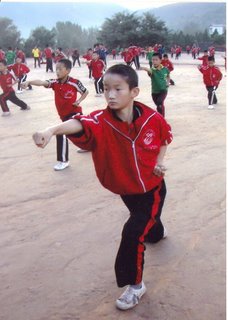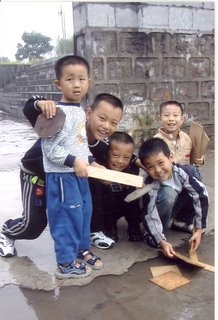Know the flag symbols and design before you go, and find out why they are as they are. There may be significant history there, and an excellent start for a conversation. Tell us about your flag.
There is a website on national flags, and how they came to be designed. See flags of the world at www.allstates-flag.com/. Click on the search menu at the top. Go to Serbia-Montenegro (Montenegro is now independent, however) and follow the clicks to its flag - a splendid double-headed gold eagle on a red ground.
Cross-border themes, improvised road trips. Cultures, migrations, spread of ideas, battles. Travel hub at Europe Road Ways. Issues of violence, warfare, responses, hub at Studying War. Index in process, see Topics By Dint.
Monday, July 31, 2006
Invasions: Crusades, Normans, Mongols, Magyars, Huns, Goths, Vandals, Ottomans, Turks, Persians, Invaders
Here is an excellent summary of the people invading other people: Crusades, Mongols, Khazars, the Rus, Ottomans, Turks, Persians, Mongols, almost you-name-it: at the History of Central Europe, at //mysite.du.edu/~etuttle/misc/europe.htm#Mong

Normans:
Here is the Cathedral at Palermo, in Sicily - Norman and Byzantine mix --and the area a crusader stop point.
Vikings:
The Vikings - Northmen- Normans - slid in their longboats rivers into Asia, Europe, Eastern Europe, Western Europe, and the oceans between, and had more of a culture than you may think. Here is a large website on the topic of Vikings, including Video. See www.pbs.org/wgbh/nova/vikings/; and for Viking ships: www.stemnet.nf.ca/CITE/vikingships.htm#Construction; and for their religious beliefs: www.pantheon.org/areas/mythology/europe/norse/articles.
They attacked Irish monasteries in about 900, maybe earlier, and the French in Paris (was this at the same time or earlier?) bought them off by giving them Normandy -thus, the Normans. The Vikings then bypassed Paris, and attacked all the way to Burgundy.
For any of these site addresses, use the basic dot-org, and the rest to navigate to where I think the best part is.

Normans:
Here is the Cathedral at Palermo, in Sicily - Norman and Byzantine mix --and the area a crusader stop point.
Vikings:
The Vikings - Northmen- Normans - slid in their longboats rivers into Asia, Europe, Eastern Europe, Western Europe, and the oceans between, and had more of a culture than you may think. Here is a large website on the topic of Vikings, including Video. See www.pbs.org/wgbh/nova/vikings/; and for Viking ships: www.stemnet.nf.ca/CITE/vikingships.htm#Construction; and for their religious beliefs: www.pantheon.org/areas/mythology/europe/norse/articles.
They attacked Irish monasteries in about 900, maybe earlier, and the French in Paris (was this at the same time or earlier?) bought them off by giving them Normandy -thus, the Normans. The Vikings then bypassed Paris, and attacked all the way to Burgundy.
For any of these site addresses, use the basic dot-org, and the rest to navigate to where I think the best part is.
Thursday, July 27, 2006
Mysteries in photos
We always come home with some pictures we just can't put in a specific place. 
Who is this unfortunate cleric, being pulled under by some kind of serpent, while the tall statue lady watches and mourns. It is Croatia somewhere, but we cannot find the story.

Bishop Gregor of Nin, at the left, 10th Century, is not a mystery. He used the local language in Roman Catholic church services, and sharply disputed Rome's position not to do so. See experts.about.com/e/n/ni/Nin. The mystery - or maybe not - is why people like him fail us. The power of a hierarchy, whether religious or political or any aspect of society, takes on a life of its own, and can be overwhelming - and not at all in line, necessarily, with the "founders." Power does what power does.
.................................................................................................................................
These are waiting to be put elsewhere. Just like stuff on the stairs to the second floor.


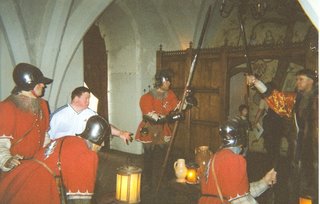
Presidents, Madame Tussaud's Wax Museum, London; and knights preparing for battle, Leeds Castle, England.
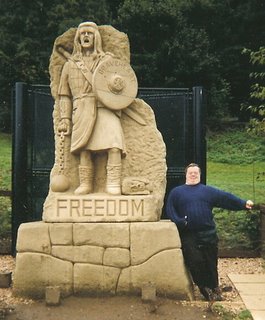
William Wallace, Stirling, Scotland.

Joan of Arc, France.

Guan Yu, China. He was a general, then became God of War. J's picture, his trip to China.
See Guan Yu

Who is this unfortunate cleric, being pulled under by some kind of serpent, while the tall statue lady watches and mourns. It is Croatia somewhere, but we cannot find the story.

Bishop Gregor of Nin, at the left, 10th Century, is not a mystery. He used the local language in Roman Catholic church services, and sharply disputed Rome's position not to do so. See experts.about.com/e/n/ni/Nin. The mystery - or maybe not - is why people like him fail us. The power of a hierarchy, whether religious or political or any aspect of society, takes on a life of its own, and can be overwhelming - and not at all in line, necessarily, with the "founders." Power does what power does.
.................................................................................................................................
These are waiting to be put elsewhere. Just like stuff on the stairs to the second floor.



Presidents, Madame Tussaud's Wax Museum, London; and knights preparing for battle, Leeds Castle, England.

William Wallace, Stirling, Scotland.

Joan of Arc, France.

Guan Yu, China. He was a general, then became God of War. J's picture, his trip to China.
See Guan Yu
Castles
An overview of castles in Europe: go to www.3dphoto.net/world/topics/castles/castles.
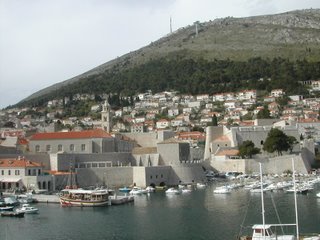
Dubrovnik, Croatia. Many, many walled towns on peninsulas and islands along coast here.

Mont St. Michel, France. This has a car causeway now.

Mount St. Michael, near Cornwall, England. No causeway. Walk or boat out. Watch tides.
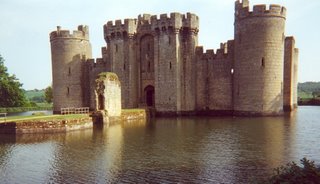
Bodiam Castle, England.

Castle Stalker, Scotland.

Dubrovnik, Croatia. Many, many walled towns on peninsulas and islands along coast here.

Mont St. Michel, France. This has a car causeway now.

Mount St. Michael, near Cornwall, England. No causeway. Walk or boat out. Watch tides.

Bodiam Castle, England.

Castle Stalker, Scotland.
Wednesday, July 26, 2006
Following ethnic groups - Roma (Gypsies); Basques; Vlachs
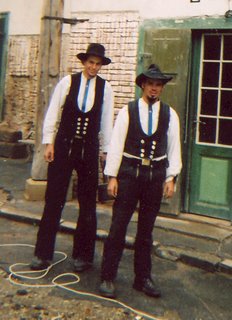 Sibiu, Romania. I was uncomfortable taking pictures of Roma girls and women, or interrupting family groups, but they were easily seen, in doorways, with companions in the street, as couples, as families at the bus or anywhere. Brightly colored clothing, long full skirts, beautiful jewelry(for the well-to-do) -distinctive.
Sibiu, Romania. I was uncomfortable taking pictures of Roma girls and women, or interrupting family groups, but they were easily seen, in doorways, with companions in the street, as couples, as families at the bus or anywhere. Brightly colored clothing, long full skirts, beautiful jewelry(for the well-to-do) -distinctive.These men may not be Roma, but instead traveling merchants from an old tradition that may have begun in the age of the Templars - see Romania Road Ways.
We did see Roma in casual, traditional and formal dress, for some occasion. And families. Very visible.
There are wide misunderstandings about Roma customs, and their history has been extremely difficult, including (according to this site) 500 years of enslavement in Romania. See this government site on the Roma - use only the dot org if the rest is not helpful. Sometimes the sites are so big that you may want assurance that you got to the right place. See www.media-diversity.org/articles_publications/A%20Problem%20Brewing%20Media%20Coverage%20of%20Roma%20in%20Romania. Roma were also subject to the mass exterminations of the holocaust. See, e.g., www.romnews.com/4_6. on the genocide issue. Roma survived and are a growing population, and remain all over Europe. In Slovenia as other places, however, the tensions remain. See Slovenia Road Ways There, the family was forced out, and has not been allowed to return.+
Roma history overall: See www.geocities.com/~patrin/timeline.
Basques: apparently, the cheek samples for DNA link this Spanish group to Celts. And, the Basques were great navigators. See Spain Road Ways. The cheek DNA testing is fascinating - I just saw an account on the History Channel, I think it was, that found a match between a young girl in the mountains of Mongolia, with reddish hair and fair skin, and a burial site of a culture of warrior women in, I believe it was, Macedonia. DNA followed the migration of the group to Mongolia. Even the patterns on the yurt, and clothing and walls in Mongolia were close to those on fabrics in the burial site.
The Vlachs are an ancient sheep-herding, nomadic people found in Romania and Greece, and probably elsewhere. See Greece Road Ways; and Romania Road Ways.
Celebrating

At Salamanca, Spain. A little night music.


At Sighetu Marmetij, Romania. Folk singers at a banquet for town officials in the big old hotel. There also were dancers. This was the Festival of the Cows, when the herds are brought down in the autumn from the higher pastures.
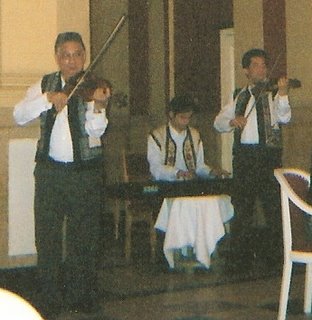
More night music, at Bucharest, Romania. We did buy their CD.

And at a banquet at Karlovac, Croatia- we were in a side booth, and suddenly music and a large group of people all appeared. Loved it. Much dancing. Also, American music along with the Croatian.
People's religions

Easter morning, Cathedral, Zadar, Croatia. Second largest city after Zagreb. Cosmopolitan. Renovations going on.

Father Stefan. You met him earlier, at the post on beards. We gave him a ride (he was hitchhiking) at Bistrita, Romania, and left him at Piatra Fantenele. He was headed for Vatra Dornei. Much talk along the way. Usually possible to cobble together what each wants to say. English is known well enough by many people, so you can get into discussions.

Horezu, Croatia, at left. Again, Orthodox Christian.
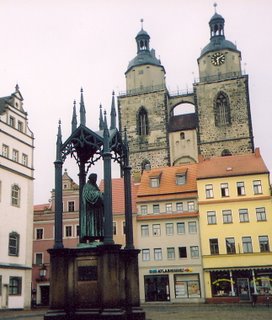
And Wittenburg, Germany, with Martin Luther.
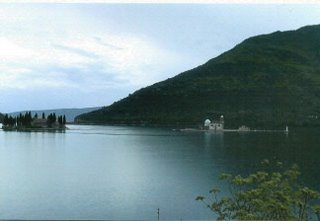
Montenegro: the islands off the town of Perast, Our Lady (manmade, from 550 years of dropping rocks on an underwater ledge, and sinking captured ships and making the island) and St. George's, with the Benedictine monastery.
Schlosskirche, Martin Luther, Wittenberg, Germany, left.

Church, abandoned, near Bogomil graves, road from Sinj, Croatia, to Mostar, Bosnia, at left.

Pilgrimage site, Medjugorje, Bosnia.

Spring, spirits, beseaching ribbons, Ireland, at left.

Glendalough, Ireland.
Teaching by painting the stories. Croatia painted monasteries. Orthodox.
Games and sports - Chess and Soccer
 Amsterdam, street chess, NL
Amsterdam, street chess, NL.
Street chess, life-sized, Amsterdam.
 Cetinje, Montenegro; soccer players
Cetinje, Montenegro; soccer playersSoccer game in a city park, Cetinje, Montenegro, at left.
These boys stopped their game to help us find a hotel and their English was remarkably good. All had on American-logo shirts.
;
Tried to locate them afterwards to get them copies of their picture, but no answers from either the US consulate or the Cetinje school system.
 Sandlot soccer, Amsterdam, NL
Sandlot soccer, Amsterdam, NL Sandlot soccer, Amsterdam, The Netherlands, at left.
A whole city block is cleared and fenced in, and sand piled in.
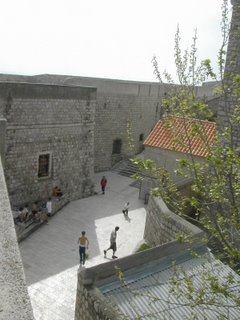 Dubrovnik, Croatia, street soccer
Dubrovnik, Croatia, street soccerStreet soccer, Dubrovnik, Croatia, at left.
Just kids
Young people, and families, doing what they do

 Rural Romania. Waiting for the school bus.
Rural Romania. Waiting for the school bus.
China. Hanging out with Mom.
China. Hanging out with Dad.
Not Car-Dan, but J's pictures on his China trip.
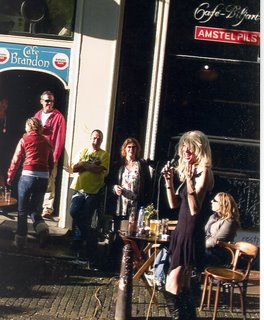
Amsterdam. Street karaoke. This young man held our attention for at least 20 minutes. He was very good. The Netherlands.

Playing pool, in the tower of the Hotel Castel Dracula, Piatra Fantanele, Croatia.

Rock concert in Romania, at Ramniu Valcea, this one to support a political candidate. Looked like the Dixie Chicks.
Active older people
 Farmers, Guilin, China (Jon's photo)
Farmers, Guilin, China (Jon's photo)Farmers at left, Guilin, China. J's picture, not Car-Dan this time.
 Ceremonial bagpiper, VE Day Memorial, Grosbeek, the Netherlands, Canadian cemetery
Ceremonial bagpiper, VE Day Memorial, Grosbeek, the Netherlands, Canadian cemeteryCanadian piper, at VE Day memorial for Canadian troops (one of Dan's grandfathers was Canadian), Grosbeek, The Netherlands.
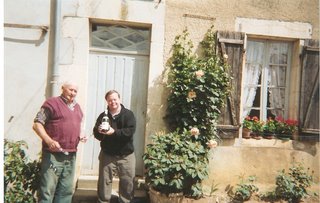 Vintner, Chablis, France
Vintner, Chablis, FranceAt Chablis, France: a family- owned winery, and a bottle of its excellence.
 Easter parishioner, Nin, Croatia
Easter parishioner, Nin, CroatiaAt Nin, Croatia, on Easter morning in the rain, parishioner near the bridge going to St. Anselm's Church.
 Farmers, Bucovina, Romania
Farmers, Bucovina, RomaniaIn Bucovina, Romania, farmers, at left.
 Women, holiday dress, Maramures, Romania
Women, holiday dress, Maramures, RomaniaAt Maramures, Romania, on a feast day (above right) people going to church or just out, and socializing up and down the street with the town.
Subscribe to:
Comments (Atom)
 Salzburg street chess, Austria
Salzburg street chess, Austria
